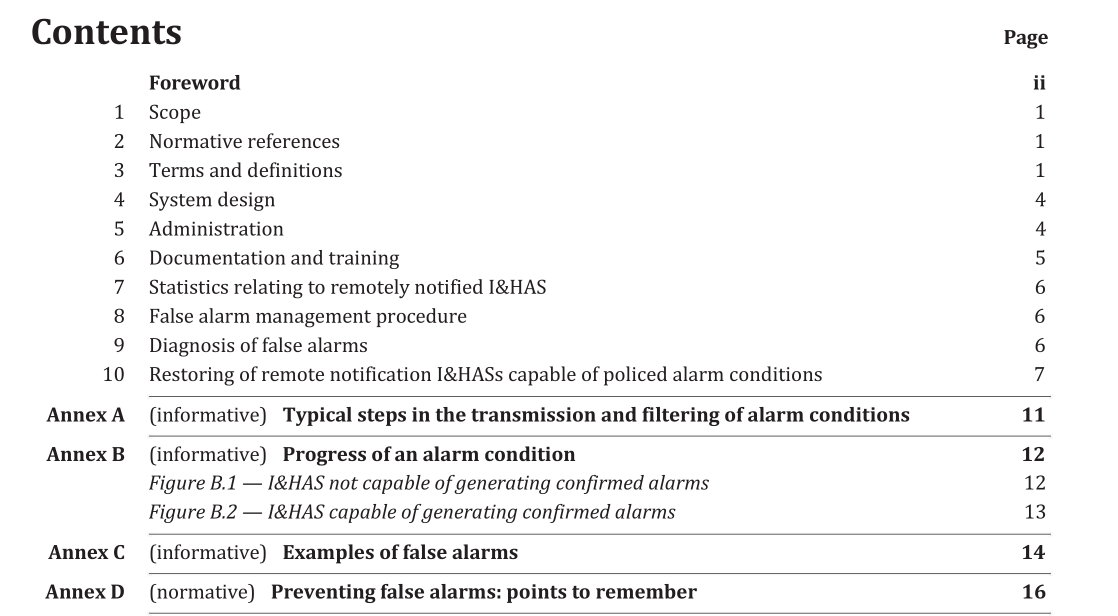BS 8473:2018 pdf download.Intruder and hold-up alarm systems – Management of false alarms – Code of practice
1 Scope
This British Standard gives guidance on the management of intruder and hold-up alarm systems (I&HAS), and the management of alarm conditions when they occur in order to reduce the nuisance factor and waste of resources in responding to false alarms.
This document applies to all remotely notified intruder and hold-up alarm systems and also applies to audible only intruder and hold-up alarm systems, except where otherwise stated.
2 Normative references
The following referenced documents are indispensable for the application of this document. For dated references, only the edition cited applies. For undated references, the latest edition of the referenced document (including any amendments) applies.
BS 5979, Code of practice for remote centres receiving signals from security systems
BS 8243:2010+A1:2014, Installation and configuration of intruder and hold-up alarm systems designed to generate confirmed alarm conditions — Code of Practice
BS 9263, Intruder and hold-up alarm systems — Commissioning, maintenance and remote support —Code of practice
BS EN 50131-1:2006+A2:2017, Alarm systems — Intrusion and hold-up systems — Part 1: System requirements
BS EN 50518, Monitoring and alarm receiving centre (all parts)
PD 6662, Scheme for the application of European Standards for intruder and hold-up alarm systems
DD 243:2004, Installation and configuration of intruder alarm systems designed to generate confirmed alarm conditions — Code of practice
DD 263:2010, Intruder and hold-up systems — Commissioning, maintenance and remote support —Code of Practice
DD CLC/TS 50131-7, Alarm systems — Intrusion systems — Part 7: Application guidelines
3 Terms and definitions
For the purposes of this British Standard, the terms and definitions given in BS EN 50131-1, PD 6662 and the following apply.
NOTE Annex A illustrates use of a number of the terms defined. Explanatory diagrams illustrating the relationship between some of the terms defined are shown in Annex B.
3.1 alarm company
organization which provides services for I&HAS
3.2 alarm condition
condition of an I&HAS, or part thereof, which results from the response of the system to the presence of a hazard
3.3 alarm filtering
procedure whereby remotely notified alarm conditions are intentionally delayed at an ARC and their status reviewed for the purpose of cancelling certain remotely notified alarm conditions, where such cancellation is authorized by the user of the I&HAS
3.10 false alert
remotely notified alarm condition, which is regarded by the ARC as cancelled, such cancellation having been authorized by the user of the I&HAS
NOTE 1 The following types of communication are examples of cancellation authorized by the user, whereby the user causes:
a) a “mis-operation signal” to be sent to the ARC affirming that the remotely notified alarm condition is to be filtered out and not extended to police; or
b) an “unset signal” to be sent to the ARC affirming that the remotely notified alarm condition is to be filtered out and not extended to police.
NOTE 2 This does not preclude the client giving general or specific standing authority, by prior written agreement,that the alarm company’s ARC may designate some alarm signals as void (i.e. cancelled).
NOTE 3 False alerts are not regarded as false alarms. False alarms are events that have not been successfully identified and filtered out, and have therefore been notified to the police.
BS 8473:2018 pdf download
